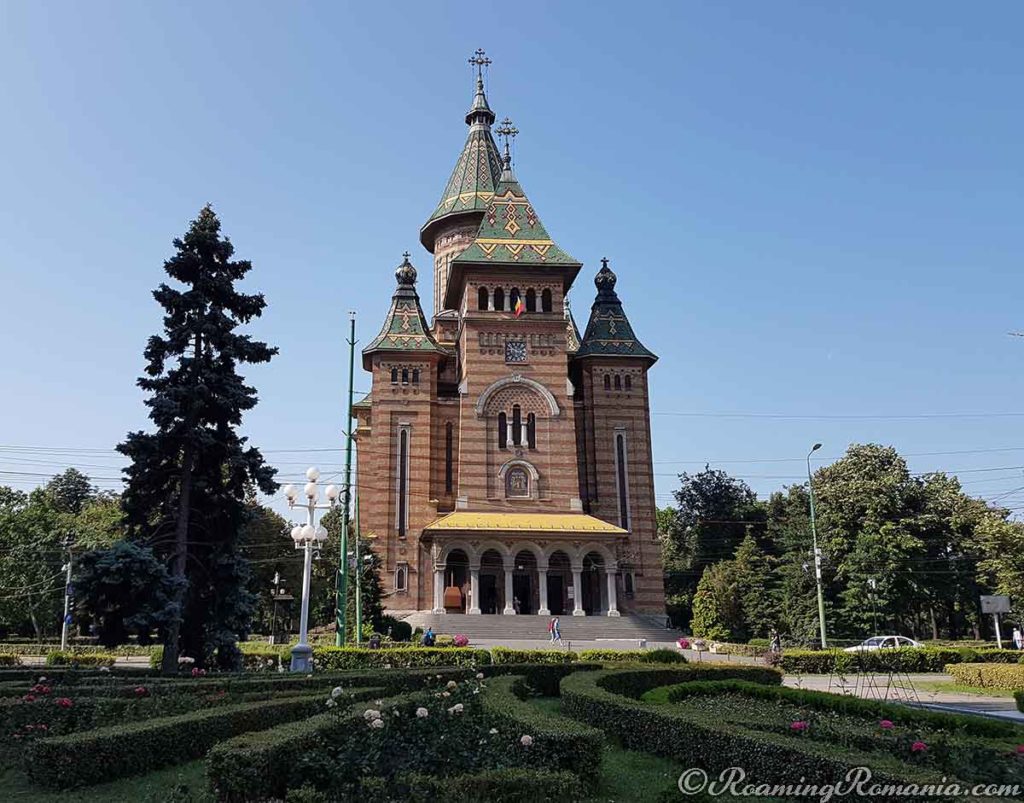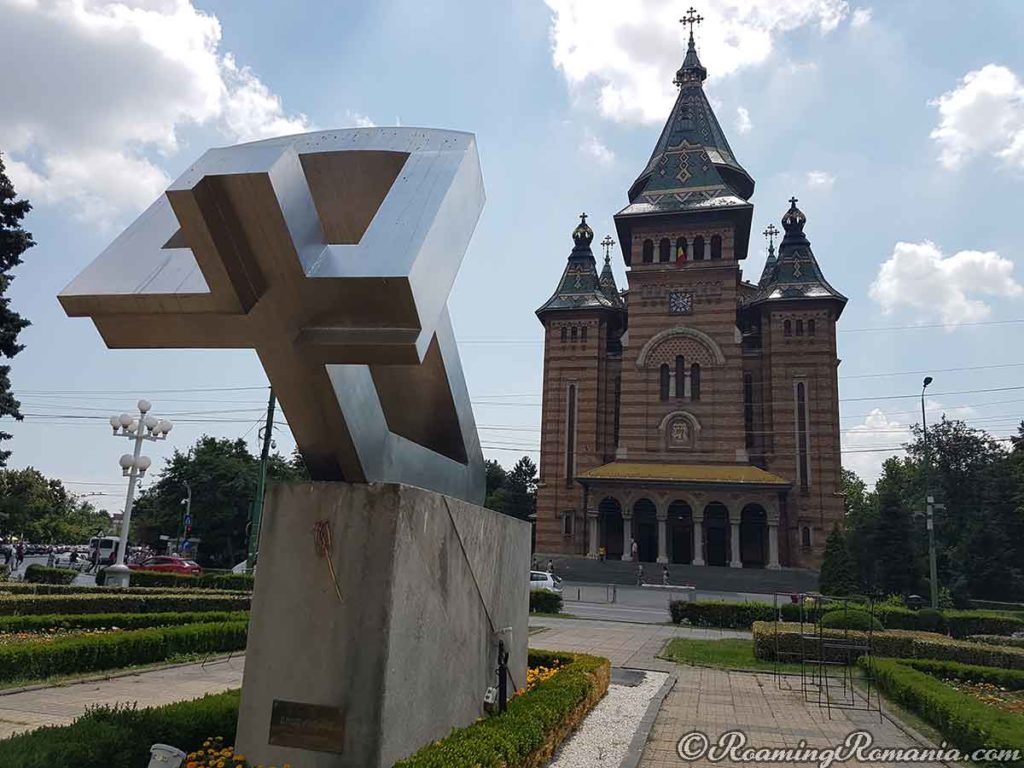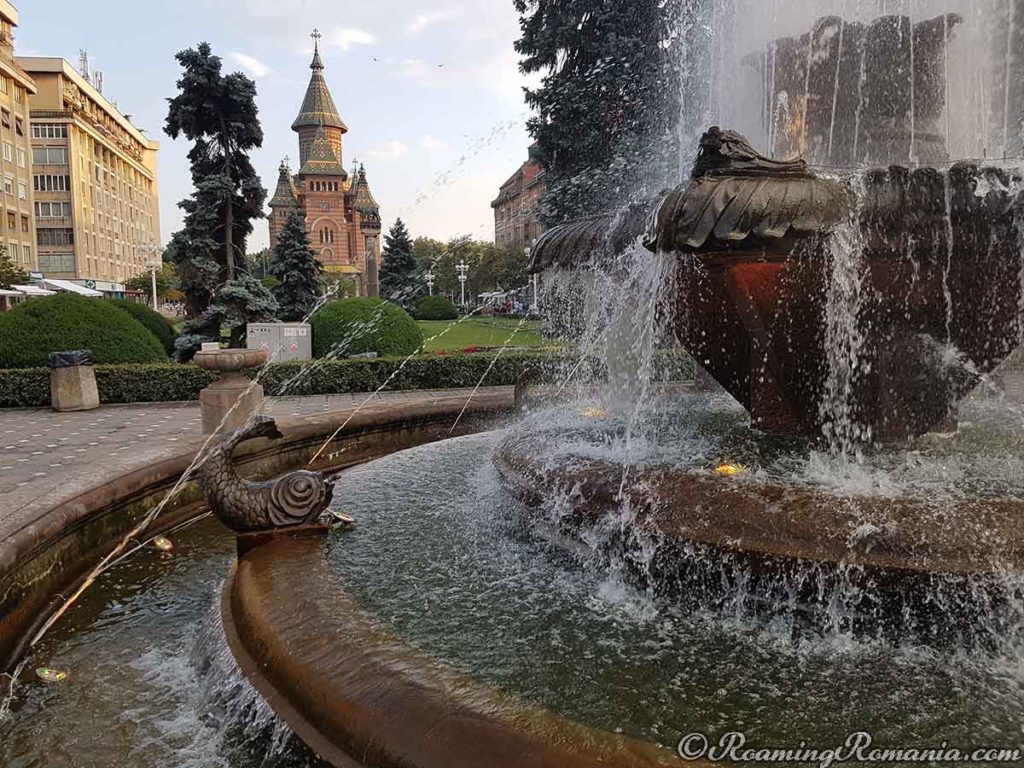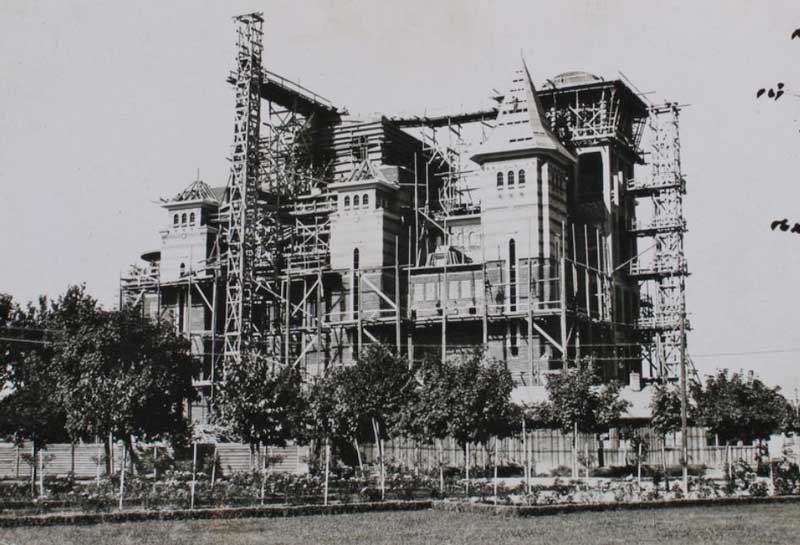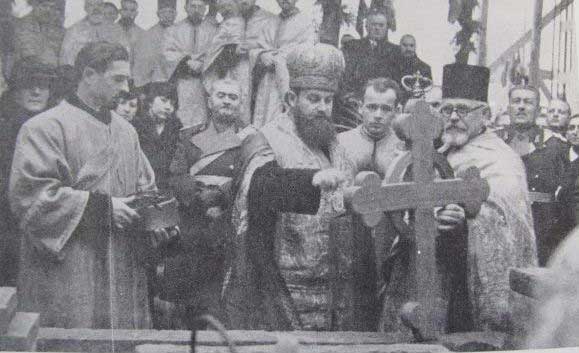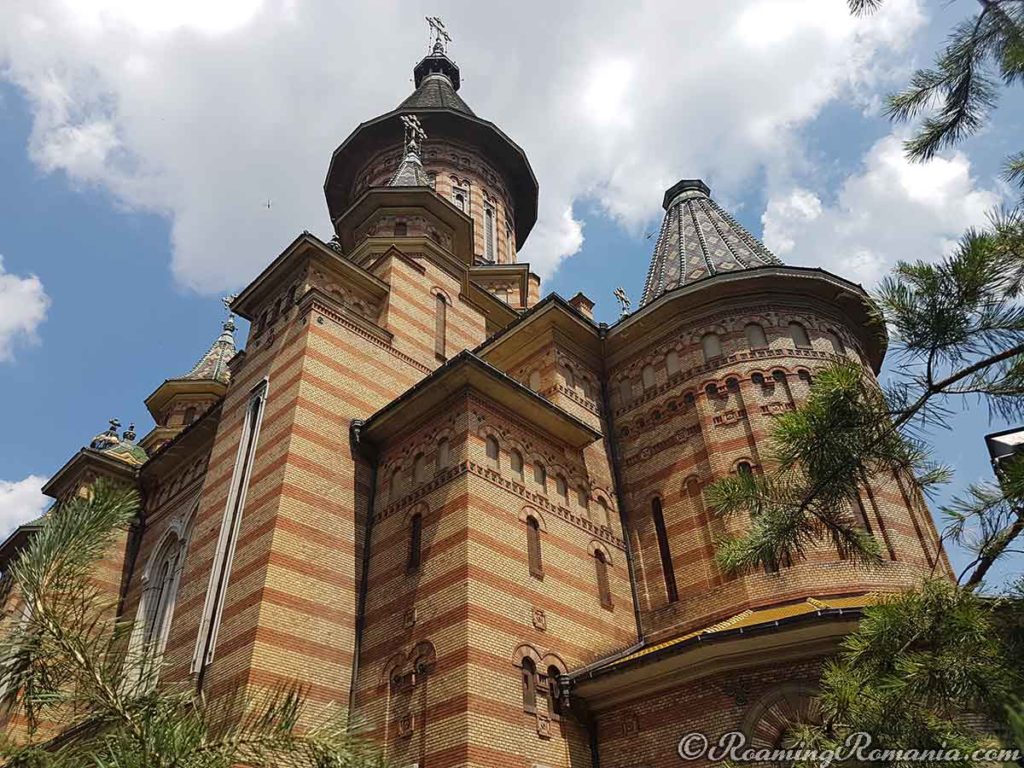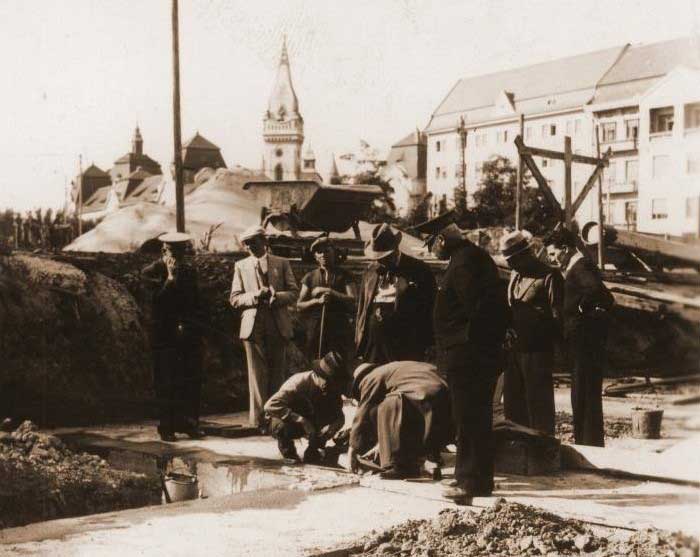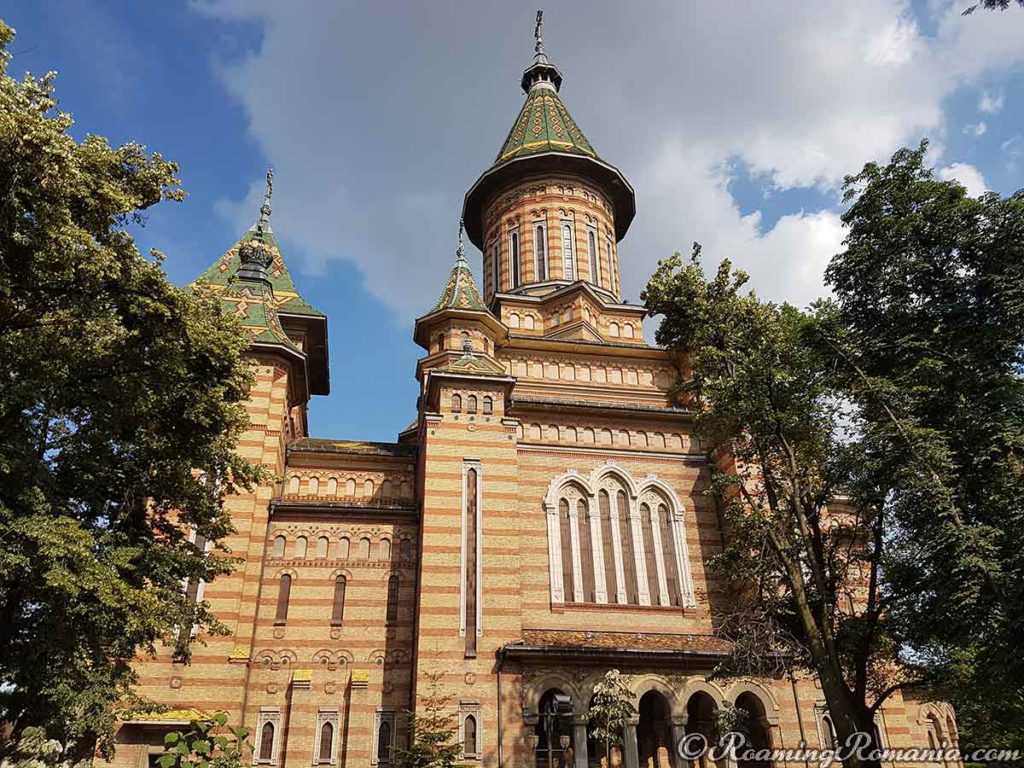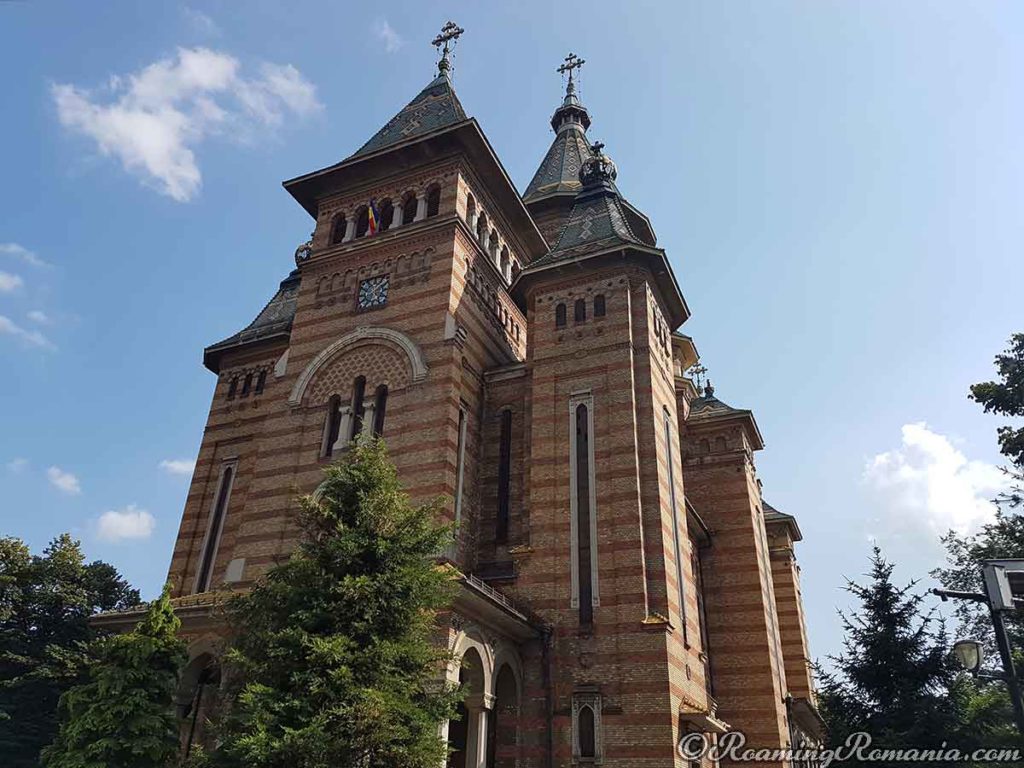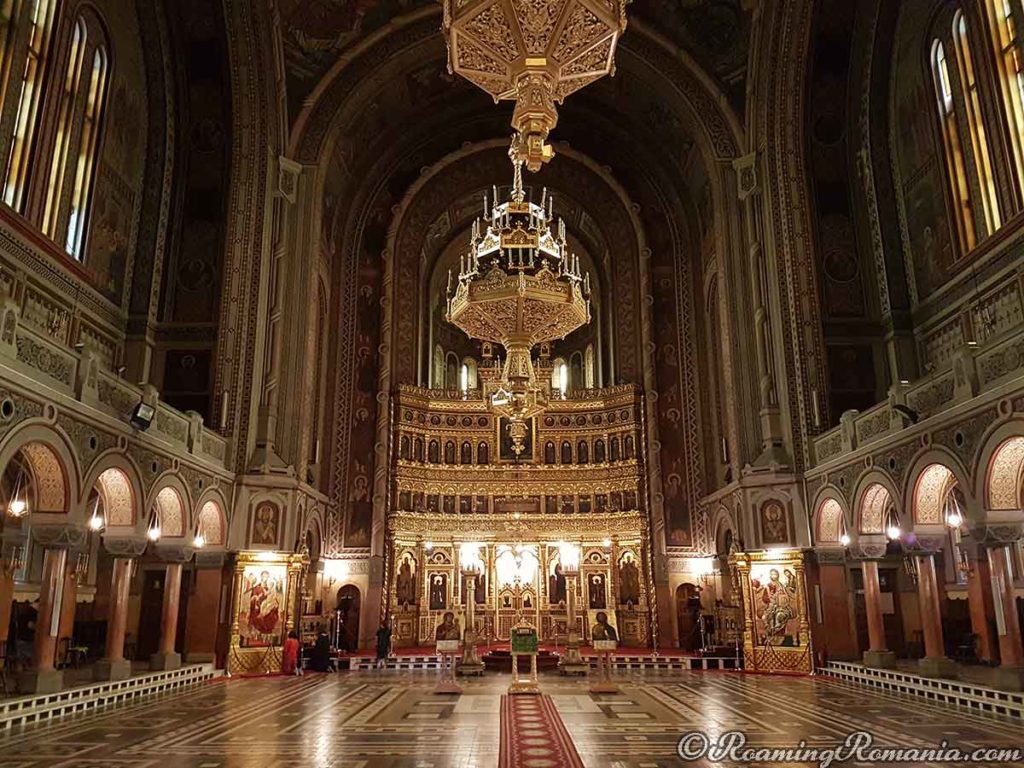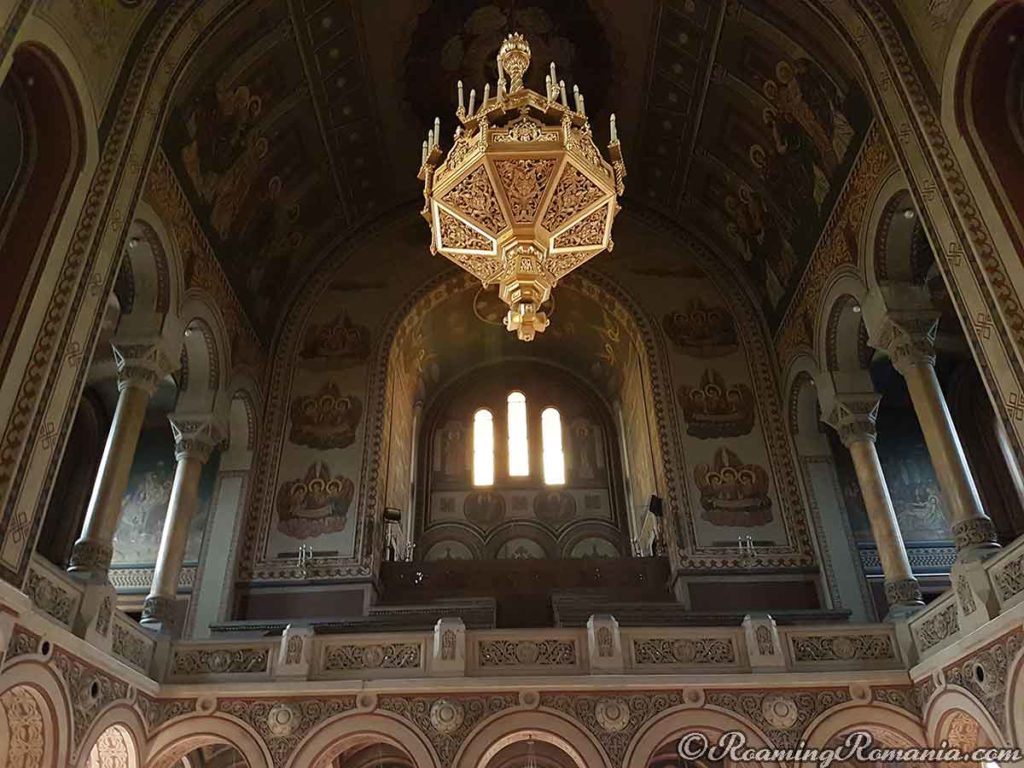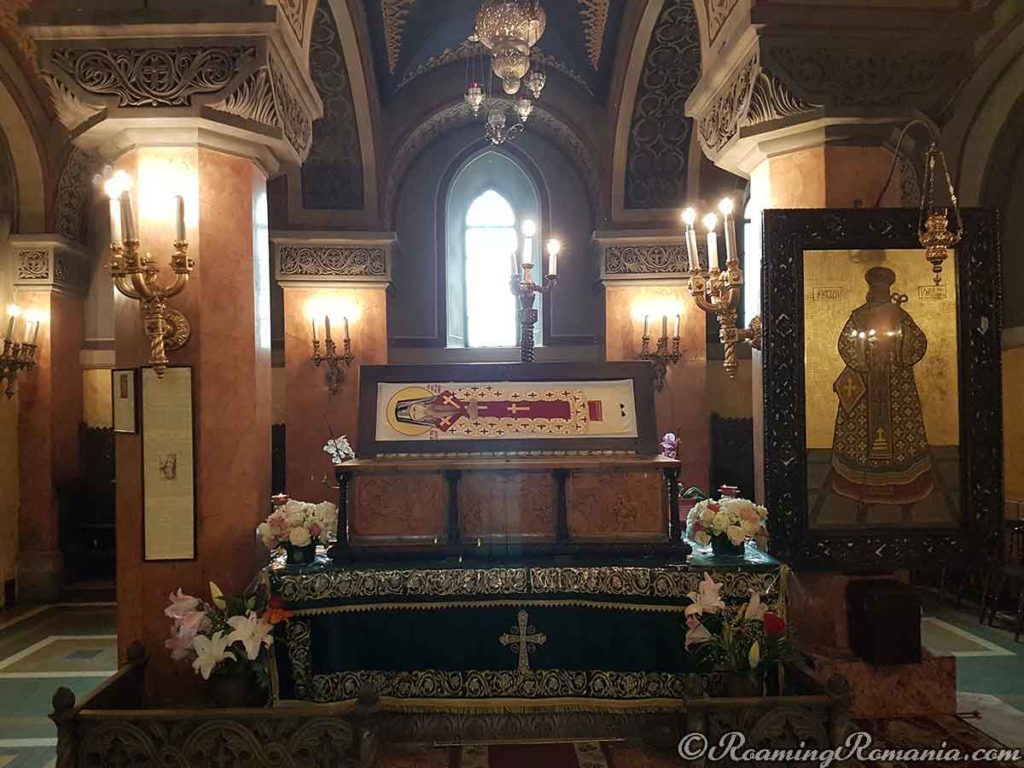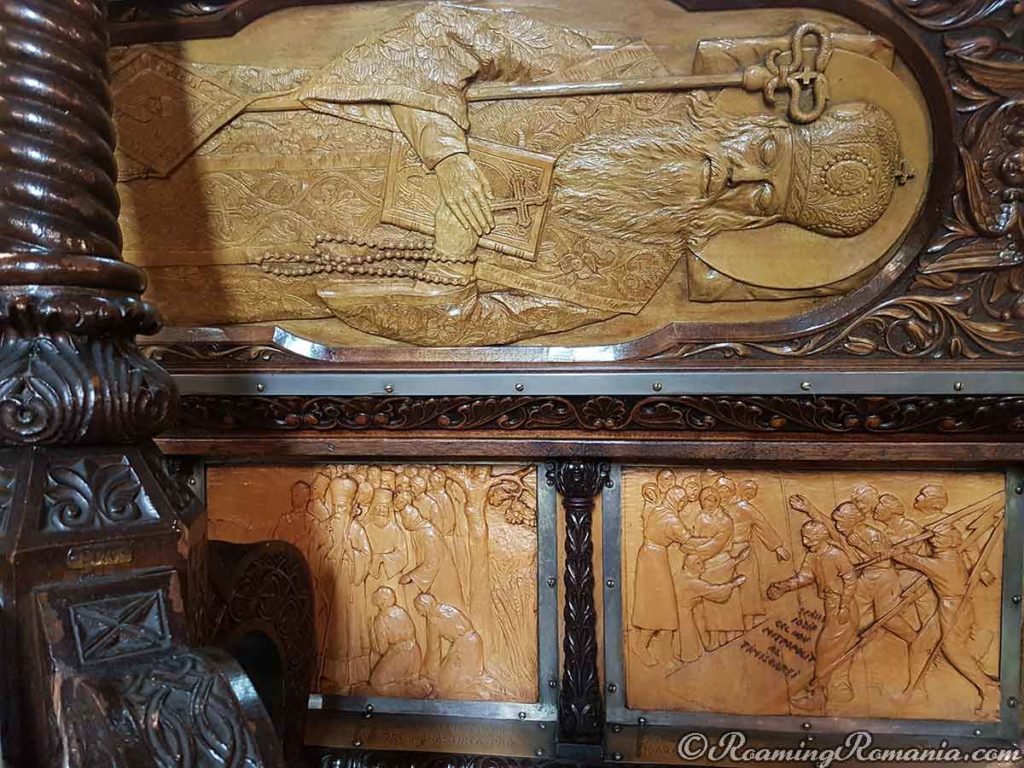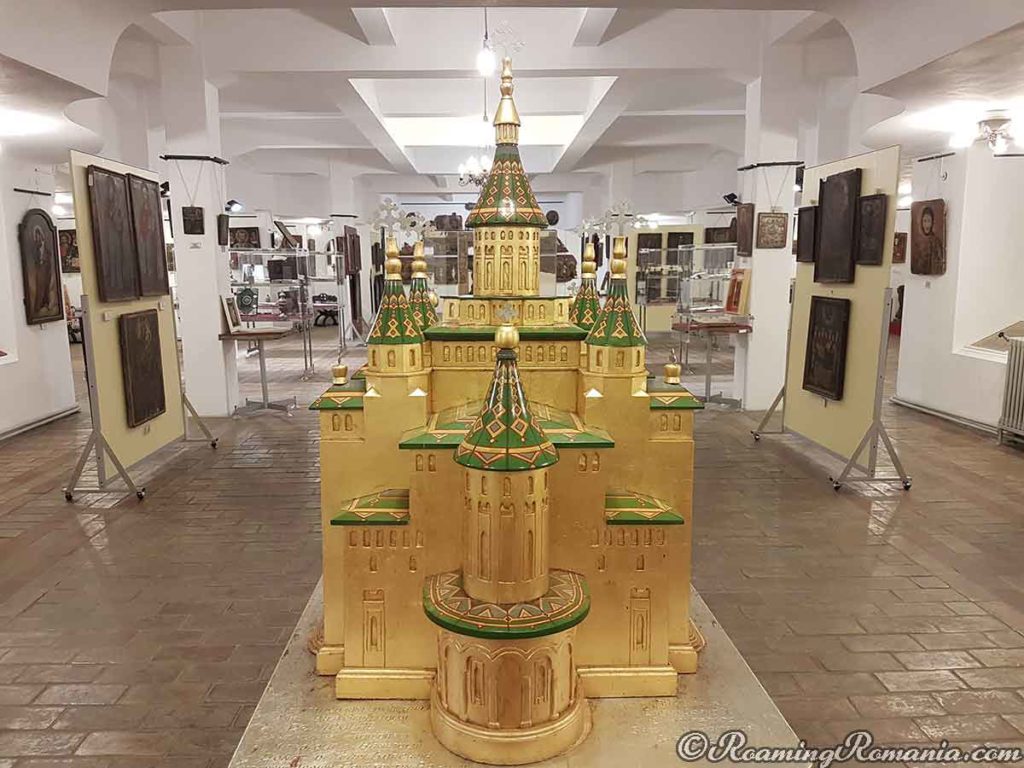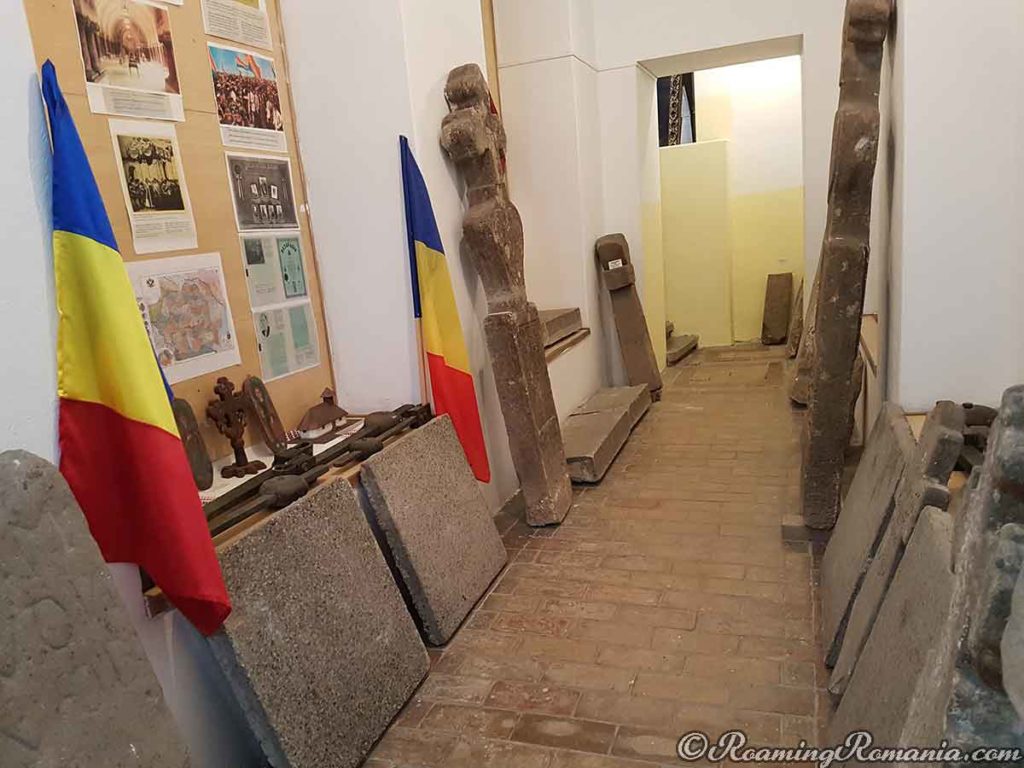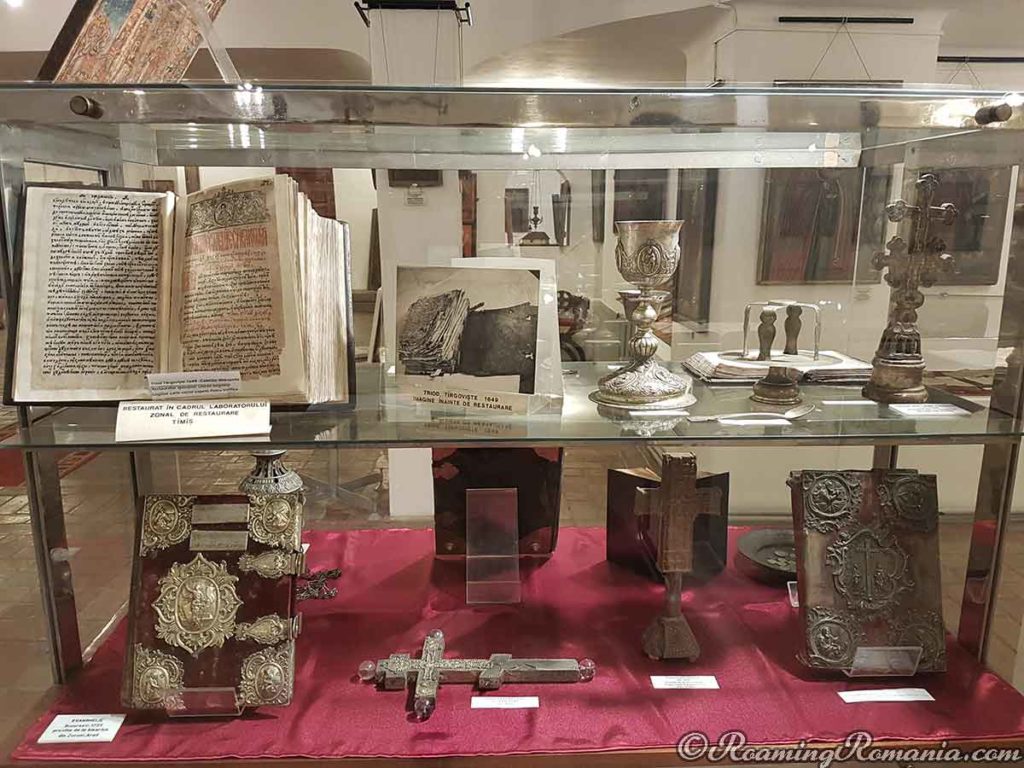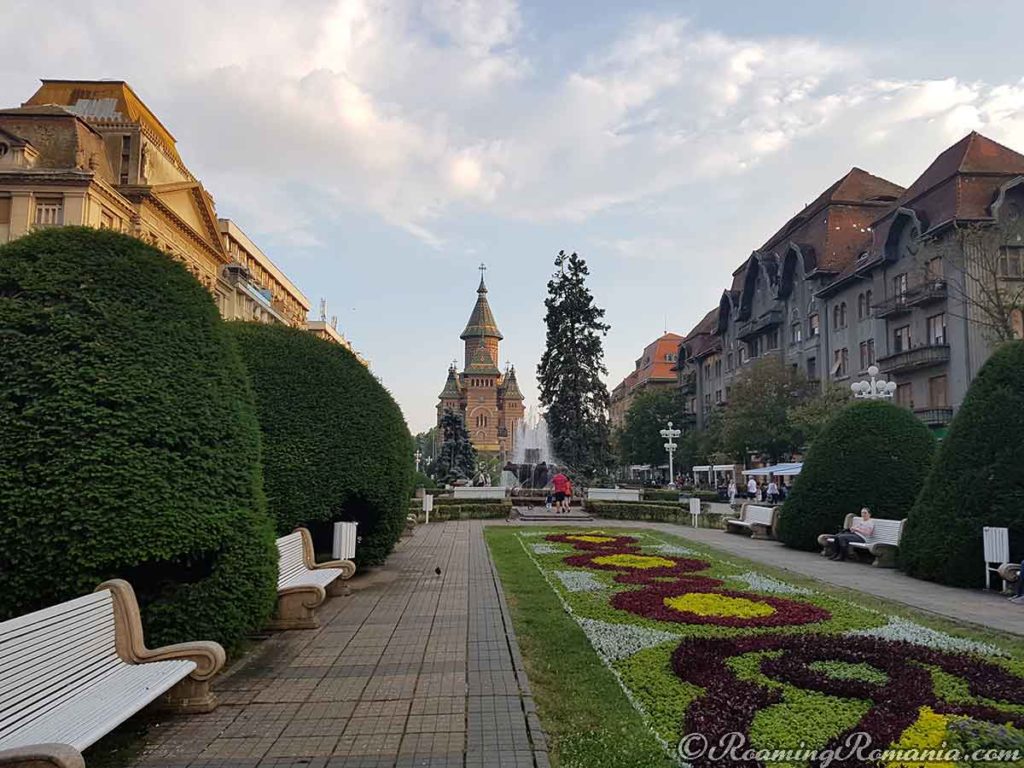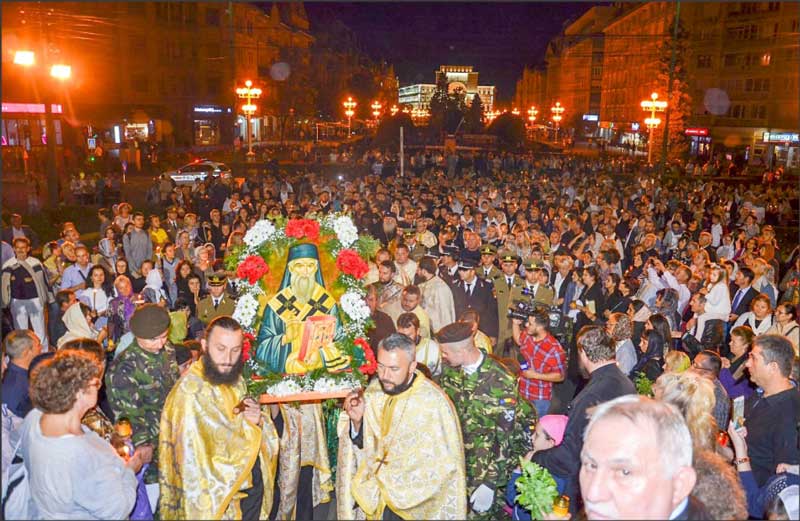Timisoara Orthodox Cathedral – Summary
The Timișoara Orthodox Metropolitan Cathedral (Catedrala Mitropolitană din Timișoara) is an early 20th-century Neo-Moldavian style Orthodox church located in Timisoara, Romania. The Orthodox Cathedral is perhaps the most iconic sight in all of Timisoara. It’s massive height and size makes the Cathedral viewable from neighborhoods situated at far distances throughout the city. The enormous Cathedral has the capacity to host around 5,000 people at any given time.
Located in the front of the city center, the cathedral is found at the most strategic and focal point of the entire city. The Timisoara Cathedral is a true testament to Romanian engineering, design, architecture, will, and achievement. Its inception became a reality through the hard work done by a team of dedicated specialists who all played significant roles in the project’s fruition.
The vast majority of the materials used to create the church came from Timisoara, and its neighboring villages. The architects, artists, sculptures, painters, builders, and various other contributors were all Romanian citizens who had one goal in mind, to create a masterpiece that would distinguish the Timisoara Orthodox Cathedral as one of the most beautiful and significant Cathedrals in the entire world.
The cathedral has a deep and rich history and plays a vital role in the way Timisoara developed as a city. Starting from its commencement in 1941, the church has provided citizens of Banat a spiritual foundation and place of worship for many decades. The Cathedral houses some of the rarest relics and most important religious artifacts found in the entire land. The Timisoara Metropolitan Cathedral is truly a magnificent sight to behold and one of the most popular destinations in all of Romania.
Timisoara Orthodox Cathedral – Table of Contents
- Timisoara Orthodox Cathedral – History
- Timisoara Orthodox Cathedral – Architecture
- Timisoara Orthodox Cathedral – Attractions
- Timisoara Orthodox Cathedral – Present Day
- Timisoara Orthodox Cathedral – Video
- Timisoara Orthodox Cathedral – Visitor Info
Timisoara Orthodox Cathedral – History
The Timisoara Orthodox Cathedral’s history begins in the year 1919 when the Banat Region united and became apart of Romania. Before this time the main religion in the area was Catholicism, the predominant religion of the Austria-Hungary empire that ruled over the land up until 1918. After the unification of Banat and Romania, the administrative leaders of Romania wanted to return the region’s core belief back to Orthodoxy. Prior to the year 1717, when it started to get eradicated, the Orthodox faith was the principal religion of the region.
The administrators of banat took a set of measures to empower and grow the Orthodox faith in the area. In 1926 they reestablished the “Old Parish of Cetate” (Cetate meaning Timisoara’s city center). They raised the rank of the Timisoara Episcopate to that of Archdiocese in 1939. And in 1947 the administrators established the Banat Metropolitanate, an assembly of Orthodox bishops and churches in the Banat region, with the head office in Timisoara.
During the period of reintroducing and reestablishing the Orthodox religion in the Banat, the city officials decided they wanted to make Timisoara the primary seat of Orthodoxy of the Region. At the time, the biggest, and most attended Orthodox church in Timisoara was the St. Elias Church (Biserica ortodoxă Sfântul Ilie). The Romanian administrators wanted to build a new, centrally located, cathedral to serve as the region’s representative Orthodox church.
The Cetate Parish of Timisoara sprung into high gear to allocate funds for their desired cathedral. They sent out many of their members far and wide across Romania to solicit donations for the funding of the church. By 1936 the parish had achieved their goal of collecting the required funds for the project. In that same year, the land where the cathedral would be built was donated by the City Hall, and an architect who would design the project was hired.
The Timisoara Orthodox Cathedral was officially inaugurated on October 6, 1946. The sanctification ceremony was headed by the Patriarch Nicodim Munteanu and attended by around 400 priests, including some of the most prominent high priests of the time. The grand inauguration ceremony was also attended by Prime Minister Petru Groza, Roman Catholic bishop Augustin Pacha, and the then king of Romania, King Michael I.
Timisoara Orthodox Cathedral – Architecture
The architect for the Timisoara Orthodox Cathedral was Ion Traianescu, a professor from the Academy of Architecture in Bucharest. Traianescu was awarded the project after he was selected as the top candidate of a contest that saw submissions from many architects from all over the land. He got his main inspiration for the project from the St. George Church of Harlau, in Romania.
Traianescu combined Moldavian, Byzantine, Gothic, Ottoman, and Renaissance, element styles to create the masterpiece. The church’s architecture uses niches under eaves (roof edges), interior shingles, and discs varnished and lacquered in multitudes of color, to resemble 14th-century Romanian monasteries like that of Cozia, and, Prislop.
Church Exterior
Construction on the cathedral began in 1936 and was carried out by Tiberiu Eremie and his crew of engineers from Bucharest. Development lasted five years and the project was finished in 1941. The church’s foundation is placed on a massive concrete slab that’s reinforced with 1,000 concrete pillars that reach 20 meters deep. The building has a length of 63 m and a width of 32 m with a total height of 90.5 m. The cathedral sits on a lot that measures 16,600 sq ft.
The outside, along with portions of the inside, of the church were painted by the highly renown Romanian painter Anastase Demian. Demian’s work of painting the cathedral had to be paused in 1939 due to the breakout of WWII. After the war had finished, he resumed painting where he left off until he completed the project. All combined it took him about six years to paint the cathedral.
The building is made out of red, yellow, and orange brick. The cathedral’s socket, colonnades (sequence of columns), and the outer frames of the windows are all made from stone brought from the nearby Romanian village of Banpotoc. The building contains 204 windows that have outside views. The windows are double sash and made out of wrought iron. 16 of the exterior windows shine light directly on and illuminate the church’s main dome.
Timisoara’s Orthodox Cathedral has an astounding 11 towers, the tallest of which measures 83.7 meters (262 ft) high. The tower roofs are covered in shingles that were manufactured in the nearby village of Jimbolia. The shingles are arranged in intricate mosaic patterns that resemble those found on traditional Romanian clothing. Each tower contains an Orthodox cross that extends upwards from its surface. The crosses were fashioned by the Timisoara blacksmith company, Iacob Schwab (Jacob Schwab).
The cathedral has 7 giant bells which, when combined, weigh around 8,000kgs. The bells were cast and created by Timisoara local, and renown bell maker Antoniu Novotny. Novotny was considered a top bellfounder of his day and is credited for creating bells for numerous churches throughout the region. The church’s bells were harmonized by the famous Romanian composer Sabin Drăgoi. The bells can be heard playing loudly and melodiously on the hour every hour.
Church Interior
The inside of the Timisoara Metropolitan Orthodox Cathedral is one of the most beautiful, artistic, and stunning church interiors in all of Romania. It’s spectacular holly paintings, gold trimmed walls, and enclosures, and huge arched ceilings and domes provide an ambiance rivaling that of the most captivating ancient holly monasteries. The cathedral is adorned with magnificent art, striking designs, and rare holly relics.
The churches interior construction plan is specific to that of Orthodox cathedrals. The building contains a giant atrium, a massive narthex at the church’s entrance, a nave which is the cathedral’s central and focal point, and a highly decorated alter arranged in the form of a Byzantine cross. Throughout the interior, there are also many other rooms of significant importance that serve clerical and other spiritual functions.
Both sides of the church’s outside entrance contain Orthodox praying blocks where lit candles are present at all times. Above the narthex lobby, there is a spectacularly crafted balcony choir that seats around 150 people. Surrounding the nave at a height of 7.5 meters there are incredibly crafted lateral galleries that contain rows of seating for attendees to witness the church’s divine worship services.
Staying consistent in the practice of using Romanian; engineers, artists, designs, and materials in constructing the Timisoara Cathedral, the church’s pilasters, column capitals, friezes, balustrades, and border frames were created by the Bucharest native Ioan Cristescu. The church’s mosaic floor tile patterns were designed by the Romanian painter Catul Bogdan. The tiles are arranged in patterns that resemble the popular patterns found on carpets in the Banat region.
Throughout the inside of the church, there are many exquisite gold and wood sculptures that were fashioned by one of Romania’s most eminent sculptors, Stefan Gajo. Gajo, of the nearby city of Deta, is credited for creating sculptured works in 46 different churches in Romania. In Gajo’s own words, the Timisoara Metropolitan Cathedral contains some of his best and most distinguished work. Gajo worked on creating sculptures for the cathedral for over 4 years before his projects finally reached completion.
Timisoara Orthodox Cathedral – Attractions
The Timișoara Orthodox Cathedral contains some of the most significant religious artifacts, and historic relics, of the Orthodox faith in all of Romania. Among the Cathedral’s most valuable possessions is the shrine which contains the relics of St. Joseph the New, and the thousands of historical artifacts located in the church’s basement museum.
Relics of St. Joseph the New of Partos
Saint Joseph the New, born 1568 in Ragusa, Dalmatia (South Croatia) was a Monk, Orthodox Saint, and former archbishop of Timisoara. St. Joseph the New was known as a healer who performed many miracles and cured hundreds of ill and crippled individuals who came to him seeking wellness.
On July 20, 1650, at the age of eighty-two, he became the Metropolitan of Timisoara. During his three-year reign as Timisoara’s archbishop, he is credited for guiding many citizens to spiritual salvation, healing their physical ailments, and even extinguishing, through prayer, a massive fire that broke out in the west part of the city.
After Saint Joseph the New retired from his archbishop duties he moved into the Partos Monastery (Mănăstirea Partoş) located 55km south of Timisoara, in the village of Partoș. While living out his remaining years at the monastery, St. Joseph the New continued to provide spiritual guidance and healing to numerous amounts of devotees who came to visit him.
St. Joseph the New passed away on August 15, 1656, at the ripe age of 88 years old. He was buried inside the Partos Monastery where his remains and relics remained guarded by monks for 300 years until they were transferred to the Timisoara Metropolitan Cathedral on October 7, 1956. St. Joseph the new was canonized by the Holy Synod of the Romanian Orthodox church on February 28, 1950.
The relics of St. Joseph the New are found just to the right of the church’s narthex (entrance lobby). The relics consist of St. Joseph’s extraordinarily fashioned casket, which contains detailed carvings that depict significant scenes of his life, his remains, and various spiritual items which belonged to the Saint.
The shrine, upon which St. Joseph’s casket sits, was created by the famed Romanian sculptor Grigore Dumitrescu. The shrine consists of highly fashioned wood, elegant satin cloth decorated in Orthodox designs, and stunning candlesticks that house illuminated candles.
The right of the shrine contains a gloriously beautiful icon of St. Joseph the New which was painted by the priest Stefan Bogoslovich. The icon has been under the ownership of the Timisoara Parish since 1782 when it was donated to the parish by its original owner, the Jewish dean, Ioan Şuboni.
Timisoara Orthodox Metropolitan Cathedral Museum
In the basement of the Timisoara Metropolitan Cathedral, there is a Museum that contains over a thousand historically significant spiritual objects which have been collected and preserved over many decades. Many of the museum’s contents are centuries old. Among the many items found in the museum are wooden, glass, and cloth embroidered icons. There are ancient scripts, books, and writings, as well as sculptures of various materials and elements.
Other fascinating objects and artifacts in the museum include Orthodox cemetery gravestones, vintage paintings, crosses, bells, wreaths, and lanterns. There are also many old and contemporary maps that show a variety of important regional sights and points of interest. Throughout the museum, there are also miniature replicas of the cathedral that show its design and progress during various stages of its construction.
The Timisoara Cathedral Museum is split into four different sections. The first section is the lapidary section and contains the museum’s stone exhibits. Found in the lapidary are funeral crosses, royal votive rocks, and inscribed stones of old churches. The oldest artifact in this section is a 2nd-century Roman headstone.
The second section of the museum contains the glass icon exhibits. The glass icons found here come primarily from the Transylvania and Banat regions of Romania. The glass icon section does a great job of distinguishing and showcasing the difference in characteristics, drawing, typology, and colors, unique to the icons respective of their regions.
The wooden icon section is the third section of the museum. This section contains spiritually painted wooden icons. The icons are predominantly from the Banat region, but the section also contains icons from various other areas in Romania. The section features work from prominent artists such as George Diaconovici, and the father-son duo of Gheorghe and Gherdanovici Lazar.
The final section in the museum contains display cases which contain the museum’s numerous ancient holy writings. Perhaps the most significant writings found in this section are that of the Romanian manuscripts of the Noul Testament de la Bălgrad (The New Testament of Balgrad) from 1648, and the Cazania lui Varlaam (The Homiliary of Metropolitan Varlaam) of 1643.
Timisoara Orthodox Metropolitan Cathedral Museum Video
Timisoara Orthodox Cathedral – Present Day
Today the Timisoara Metropolitan Cathedral is one of the city’s top tourist destinations. Visitors come from all over the world to marvel at the building’s amazing architecture, to photograph its enchanting interior, to visit the historical elements within, and even to attend its church services. Aside from the high volume of tourism the church receives, the cathedral also sees weekly attendance from local members who come to pray and seek spiritual guidance within its walls.
The church also hosts highly attended special events which are specific to the Orthodox faith. One such event was the procession with the relics of Saint Joseph the New of Partos. This three-day event took place September 14-16. The event commemorated the life of St. Joseph the New. Participants of the event prayed at St. Josephs shrine, partook in a procession march on a route through the city that is said to be the path the Saint took when he left Timisoara and attended divine services at the cathedral.
Another often overlooked attraction at the church is the Cathedral Park (Parcul Catedralei) located directly behind the building. The heavily forested park provides a tranquil experience in nature with the benefits of being in close proximity to the city center. There are paved walking trails as well as sitting benches scattered throughout the park. If you follow the park trails southwards you will eventually reach the Bega River which is located at the end of the park.
Timisoara Orthodox Cathedral – Video
Timisoara Orthodox Cathedral – Visitor Info
Location
The Timisoara Metropolitan Cathedral is located in the city’s center at the address: Bulevardul Regele Ferdinand I. The church is found directly across the street from Piata Victoriei (Victory Square), and at the center of the Parcul Catedralei (Cathedral Park).
Visitation
The cathedral is open daily and visitors are allowed to walk around and photograph both interior and exterior portions of the building. Tourist visitation is limited during Sunday church services.
A full schedule of the church’s service hours is found here. Access to the museum is free of charge, although donations are accepted.
The Cathedral’s Museum Hours are as Follows:
| Sun-Mon: | Closed |
| Tue-Sat: | 10am to 5pm |
